
The following documents began the discussion for attaining Air-Mech-Strike capabilities. The list is far from complete with the many works of Russian Air-Mech theorists currently unavailable.
1930s
Russians actually streamlined external load (SEL) carry armored cars and light tanks under TB-series bombers to include AIRDROP WITHOUT PARACHUTES! The works of Grohovskiy with TB-1, TB-2 and TB-3 bombers.
www.secretprojects.co.uk/forum/index.php/topic,724.0.html

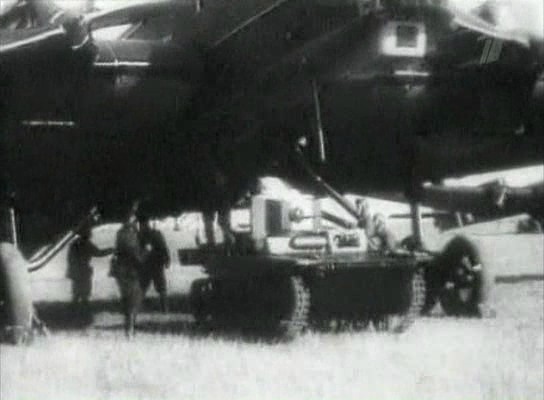
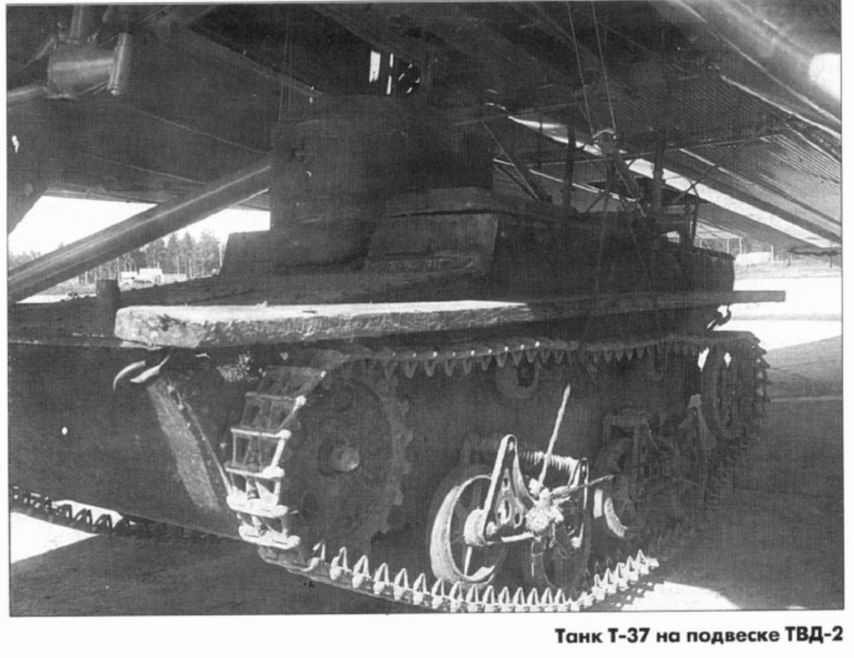
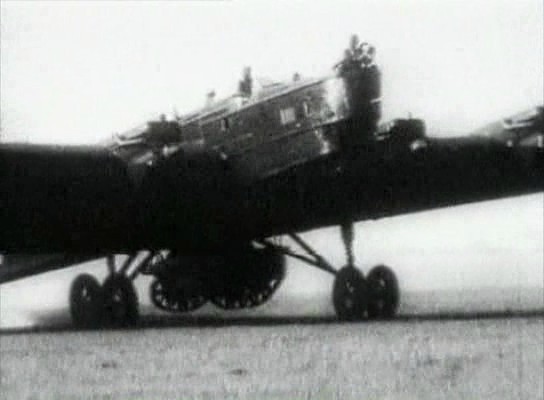


Legendary Walter Christie's M1932 Flying Light Tank is still the best concept to date and still demands fulfillment using today's technologies.
1940s
With WW2 underway, ways to make tanks fly are explored....

Hafner's Valentine medium tank with rotors to be towed in flight

Russian Antonov A-40 KT-40 fixed wings to tow a T60 Light tank as a glider

Japanese KU6 Light Tank Glider Combo
Project Maeda Ku-6
Even air/ground vehicles are considered...
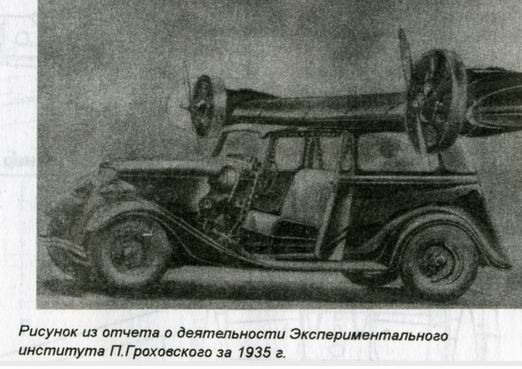
Grohovskiy G-26 (Attempt of the creation flying car)
1942
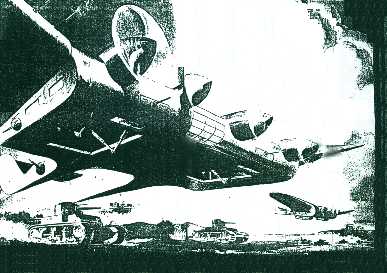
Vincent Burnelli's Flying Wing Tank Transporter, Popular Mechanix, June 1942, pages 163-167, "Burnelli did it first"
MG James Gavin's Airborne Warfare
U.S. Army Military Review, December 1947, The Future of Airborne Operations
1954
Then Major General James M. Gavin's article in Harper's magazine (April 1954) "Cavalry, and I Don't Mean Horses!" Key quotation:
LTG Tolson writes:
"Indicated the sort of vision some enthusiasts had for the future. The article was an unofficial summation of several staff studies prepared in his office while he was G-3, Department of the Army. During this period I was General Gavin's Director of Doctrine and Combat Development, and through his Deputy, Major General Paul D. Adams, he had tasked my shop to design new hypothetical cavalry organizations around the potential of the helicopter. These new units were to perform the traditional missions of horse cavalry using a third dimension and a ten-fold increase in speed. Not entirely by accident, one of the key action officers was a young Major Edwin C. ("Spec") Powell, later to become Director of Army Aviation.
The growing helicopter industry was groping for direction from the military. At the same time, its engineers were pushing design proposals to potential military customers who weren't it all sure of their requirements. Many new approaches to vertical (or near vertical) flight were being tested as a replacement for, or an extension of, the helicopter. For the first time, the Army placed major Research and Development funds in aeronautic programs.
There were precious few guidelines for airmobile doctrine in the early fifties and none had the formal stamp as official U. S. Army policy. Recognizing this deficiency, General Gavin decided to plant the seed in the Army School System. Through the good offices of Major General Robert M. Young, G-1 of the Army, and Major General Joseph H. Harper, Commandant of the Infantry School, I was ordered to Fort Benning with instructions to develop tactical doctrine for the combat employment of helicopters.
As Director of the Airborne Department, I was able to broaden its charter and change the name to the Airborne-Army Aviation Department. A new Airmobility Division was established as the focal point for doctrinal innovation. We started gathering the necessary people and equipment to develop procedures, organizational concepts, and materiel requirements for airmobility. A helicopter company, equipped with H-19's and, later, H-34's was placed at our disposal for field experiments. The company commander, Major William C. Howell, Jr., was to become President Eisenhower's personal helicopter pilot and, after retirement, curator of the U. S. Army Aviation Museum at Fort Rucker.
The results of a few months of concentrated activity were climaxed with the publication of a new field manual, FM 57-35, "Army Transport Aviation-Combat Operations." The basic tactics and techniques described in this manual stood the test of time and would be vindicated in the tests of the 11th Air Assault Division and in Vietnam.
The first formal military requirement for an aerial weapon for Army helicopters was initiated during this same period at Fort Benning and, subsequently, approved through the chains of command by Department of the Army. The requirement specified a lightweight, simple, flexible turret gun to be provided for all Army transport helicopters. Tactical experiments had proven the obvious requirement for some type of suppressive gunfire to be delivered by transport helicopters during the critical approach phase of a combat assault. Unfortunately, the light turret gun was never developed as conceived, but the Ordnance Corps latched onto the requirement as the justification of expenditures in the initial development of helicopter armament".
LTG Hamilton Howze's Air Mobility Requirements Board report

General Hamilton Howze by an UH-1 Huey Helicopter
The final report of the Howze Board was submitted on 20 August 1962. The Air Assault Division was the principal tactical innovation. As compared with about one hundred aircraft in the standard Division, it would have 459. Airmobility would be achieved by extensive reduction in ground vehicles from 3,452 down to 1,100 which would also reduce the airlift requirement for strategic deployment. [Critical error: loss of ground mobility had those vehicles been all-terrain tracked types] Despite the reduction in total number of vehicles the cost of the new Division, based upon the initial investment and a five-year operating cost, was about half again the cost of an infantry Division. Artillery consisted of only 105mm howitzers and Little John surface-to-surface ballistic rockets (airtransportable in the Chinook helicopter) . Augmenting this greatly reduced firepower, the Division would employ twenty-four armed Mohawks and 36 Huey helicopters armed with 2.75-inch rockets.
The aircraft of the Division could lift one-third of its assault elements at one time. Three Brigade headquarters provided major tactical sub-divisions to which the fighting battalions and support elements would be assigned according to the nature of the task and the terrain. The Brigades in turn could mix units assigned to them as could the Battalions and to a lesser extent the subordinate units of the Battalions. All the essential elements of combat power maneuver forces, reconnaissance, firepower, communications, and service support-were present.
The Board also recommended the organization of an Air Cavalry combat Brigade having 316 aircraft, 144 of which would be attack helicopters. Its function was the classical one for Cavalry-to screen, reconnoiter, and wage delaying actions. Unlike the Air Assault Division which was designed to join battle on the ground, all of the Air Cavalry combat Brigade was to be Airborne including its anti-tank capacity.
A distinct feature of the proposed Air Assault operations was the requirement for an increased use of support aircraft to carry supplies as far forward as the tactical situation would permit. The Board envisioned Caribous and Chinooks located in the forward Army area to deliver men, equipment, and supplies after Air Force aircraft had deposited them as far forward as possible.
The Board presented Mr. McNamara five alternative programs which would modernize the Army structure by replacing conventional forces by airmobile forces. Of the five programs the Board recommended its Alternative Three as the "most responsive to the requirement and most compatible with the Army's mission and overall structure." This program within six years would provide eleven Reorganization Objective Army Divisions, five Air Assault Divisions, three Air Cavalry combat Brigades, and five Air transport Brigades. It would also increase the mobility of other combat units and the effectiveness of their logistical support.
The Board emphasized the quantitative and qualitative improvements that would be necessary for Army aviation personnel programs. Its proposed alternative would require 8,900 aviators in 1963, growing to 20,600 in 1968. The Board foresaw an increased need for warrant officer pilots and recommended an officer to warrant officer ratio of one to one by the end of five years. It also recommended major changes in the officer career program to enhance their training, administration, and utilization.
In a letter prefacing the final report, General Howze commented that the job was in some respects incomplete and further testing was recommended. He said, "The foregoing does not indicate that I consider the Board's findings unvalidated or its judgment faulty. The time made available although not sufficient to prove all details of the Board's recommendations as respects organization, personnel, equipment, maintenance and doctrine, was quite sufficient to enable it, with conviction, to chart a course of action which will serve to increase markedly the combat and logistical efficiency of the Army." The Board was aware that its proposals were not infallible and that subsequent tests and developments could alter some elements of the proposed force structure. Therefore, the Board recommended a continuing program of field tests using the first units becoming operational under the activation schedule. It also recommended that progress on the Board's proposals be reviewed annually as a safeguard against any errors in details of organization and any slippage in implementing the program.
The single major conclusion reached by the Board was terse and emphatic. "The Board has only a single, general conclusion," stated General Howze. "Adoption by the Army of the airmobile concept-however imperfectly it may be described and justified in this report-is necessary and desirable. In some respects the transition is inevitable, just as was that from animal mobility to motor."
The Howze Board accomplished its mission in 90 days, from the original assignment to the finished report. In view of the enormous staffing task involved, and the sheer size of the analytical task, such alacrity has few parallels in staff work in or out of the military service.
The Office of the Secretary of Defense, having received what it had asked for, now turned the report over to its systems analysts in the Office of the Comptroller to study in minute detail all 3,500 pages of the main report. The review by the office of the Secretary of Defense Comptroller was to focus on certain procurement actions and to make certain recommendations of its own which had no relation to the Howze Board's basic recommendations.
In mid-September 1962 the Chief of Staff directed General Howze, Colonel Norton, and one of the editors of the Board Report to work in his office in preparing rebuttals for the various attacks that were coming from all directions. This "ten-day" TDY mission was to last almost until Christmas (with General Howze being replaced by General Williams when the former had to return to his command at Fort Bragg as commander of the Strategic Army Corps during the Cuban missile crisis).
Throughout the fall of 1962 it appeared, at times, that the work of the Howze Board was going to be studied to death and finally filed away for historians. The fact that it survived attacks by members of Congress, the Air Force, and conservative elements within the Army was a tribute both to the soundness of its basic conclusions and to the dedicated officers within the Army who believed that airmobility was the wave of the future.
Lieutenant General John J. Tolson's Vietnam Studies: AIRMOBILITY 1961-1971
Colonel (Major) Michael Kazmierski's U.S. Army Command and General Staff college master's Thesis: United States Army Power Projection in the 21st Century: the Conventional Airborne Forces must be modernized to meet the Army Chief of Staff's Strategic Force Requirements and the nation's future threats Fort Leavenworth, Kansas
Major [LTC] Mike Robel's Operational Mobility for Light Infantry Military Review, July issue, pages 41-48 offers M113 Gavins in a transportation battalion as needed by armored mobility needy light infantry--General Gavin's original intent for the M113 in the Pentomic Army BattleGroup force structure--still a viable idea today utilizing "Delta" weapons companies instead as owner/operators.
1991
Ralph Zumbro and James Walker's PUMA FORCE Adventure publishing, pocket books, NY:
Colonel Wallace P. Franz (R)'s AirMechanization: The Next Generation , Military Review
Major E.C. Parrish III's "Its time to consider glider delivery of the M1 Abrams", U.S. Army ARMOR magazine, September-October, pp. 27-38
Major E.C. Parrish III's "Gliders carrying main battle tanks?", U.S. Army ARMOR magazine, September-October, pp. 46-49


Ralph Zumbro's Armored Expeditionary Forces, U.S. Army Armor magazine, Fort Knox, Kentucky, September-October 1995, pp. 14-16
German Army Lieutenant Colonel Wolfgang Mettler's "Airborne Anti-Tank Battalion", U.S. Army Infantry magazine, January-February 1995, pages 24-29


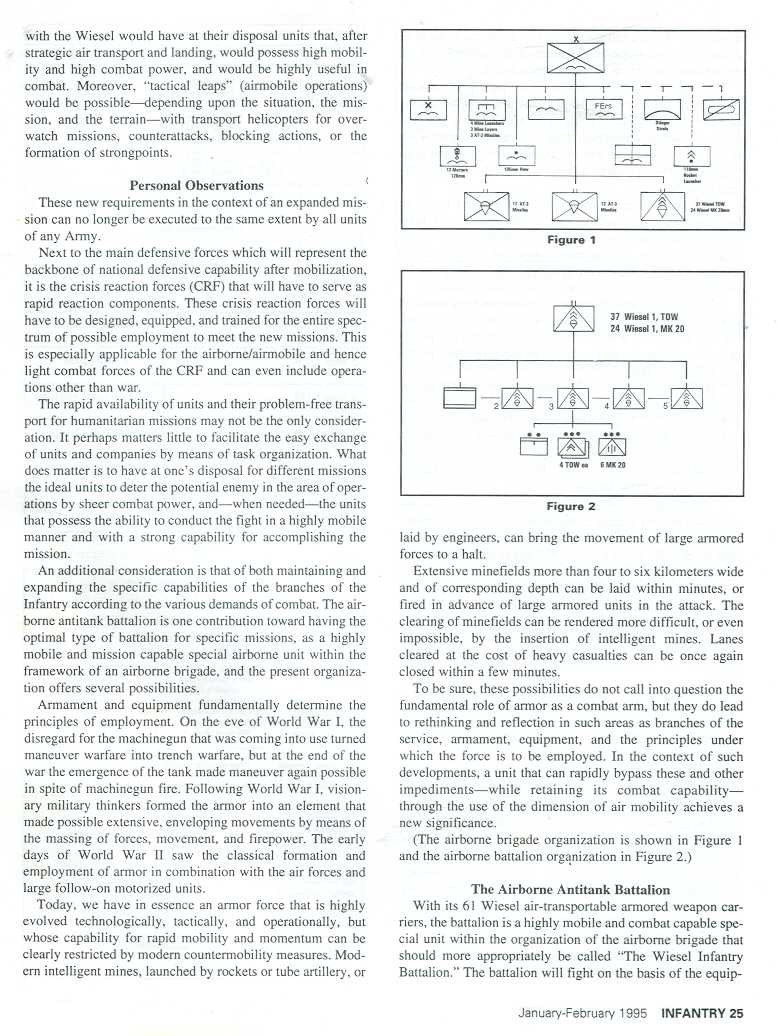

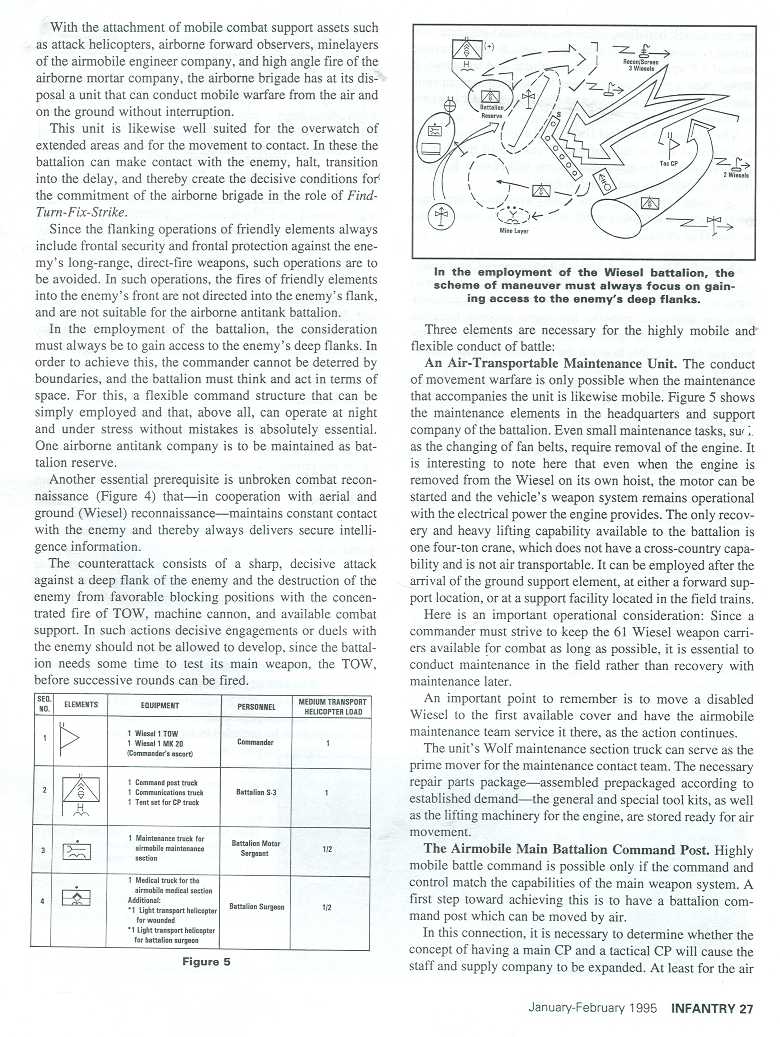


Colonel David Glantz's History of the Russian Airborne U.S. Army Combat Studies Institute, Fort Leavenworth, Kansas
Professor Gabriel D. Boehler and Major William C. Schneck On the need and feasability of a Very Heavy Lift Helicopter (VHLH)in support of the Army's Force XXI Operations Concept Presented at the American Helicopter Society 52nd Annual Forum, Washington, D.C., June 4-6, 1996.
Major Burdette K. Thompson's "Where's the light armor? Enhancing the firepower of early entry forces", monograph, U.S. Army School of Advanced Military Studies, USACGSC, Fort Leavenworth, Kansas, First Term AY 96-97, 19970506038
Major Charles A. Jarnot's U.S. Army Command and General Staff College (CGSC) Master's Thesis, Air-Mech XXI: New Revolution in Maneuver Warfare, 110 pages
Stan Crist's Modernizing the Airborne, U.S. Army Infantry magazine, July-December 1997
Charles Jarnot's article based on his CGSC thesis; "Air-Mech-Strike: Revolution in Maneuver Warfare", U.S. Army Military Review, March-April 1997

Ralph Zumbro's The Iron Cavalry Mass Market Paperback - 528 pages (December 1998) Pocket Books; ISBN: 0671013904
Mike Sparks' Crisis of confidence in Armor? U.S. Army ARMOR magazine, Fort Knox, Kentucky, March-April 1998 (with hyperlinked cross-references)
PDF version on the ARMOR magazine web site
Paul Hornback's The Wheels versus Track Dilemma U.S. Army ARMOR magazine, Fort Knox, Kentucky, March-April 1998
Unrestricted Warfare by Red Chinese communist Army Colonels Qiao Liang and Wang Xiangsui (Beijing: PLA Literature and Arts Publishing House, February 1999)
Brigadier General Huba Wass de Czege, U.S. Army, Retired, and Lieutenant Colonel Antulio J. Echevarria II, U.S. Army's Insights for a Power-Projection Army Military Review, May-June 2000
LTC Lester Grau and Jacob Kipp's [Wing-In-Ground effect seacraft] The Tyranny of Time and Distance: Bridging the Pacific Military Review, July-August 2000
Don Loughlin's Wheels versus tracks Defense Daily News, September 2000

Air-Mech-Strike: 3-Dimensional Phalanx; full spectrum maneuver warfare to dominate the 21st century
"If your enemy is secure at all points, be prepared for him. If he is in superior strength, evade him. If your opponent is tempermental, seek to irritate him. Pretend to be weak, that he may grow arrogant. If he is taking his ease, give him no rest. If his forces are united, separate them. If sovereign and subject are in accord, put division between them. Attack him where he is unprepared, appear where you are not expected."
AMS-SG: BG David Grange (R), BG Huba Wass de Czege (R), LTC Richard Liebert, LTC Lester Grau (R), Michael Sparks, John Richards, Emery Nelson, Jacob Kipp, Carol Murphy
AMS eBook ONLINE for FREE:
Air-Mech-Strike: Asymmetric Maneuver Warfare for the 21st Century
U.S. Army ARMOR magazine, March-April 2001
CPT John Wilson Jr.
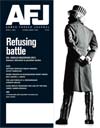
Full-spectrum transformation NOW! Armed Forces Journal International, March 2001
BG David Grange (R)
Mr. Joseph Cassidy
Rotorcraft for war, PDA report
Dr. Lutz Unterseher, Chairman, Study Group on Alternative Security Policy (SAS)
Captain Carlton Meyer's Update helicopter Assault Tactics! in G2mil.com


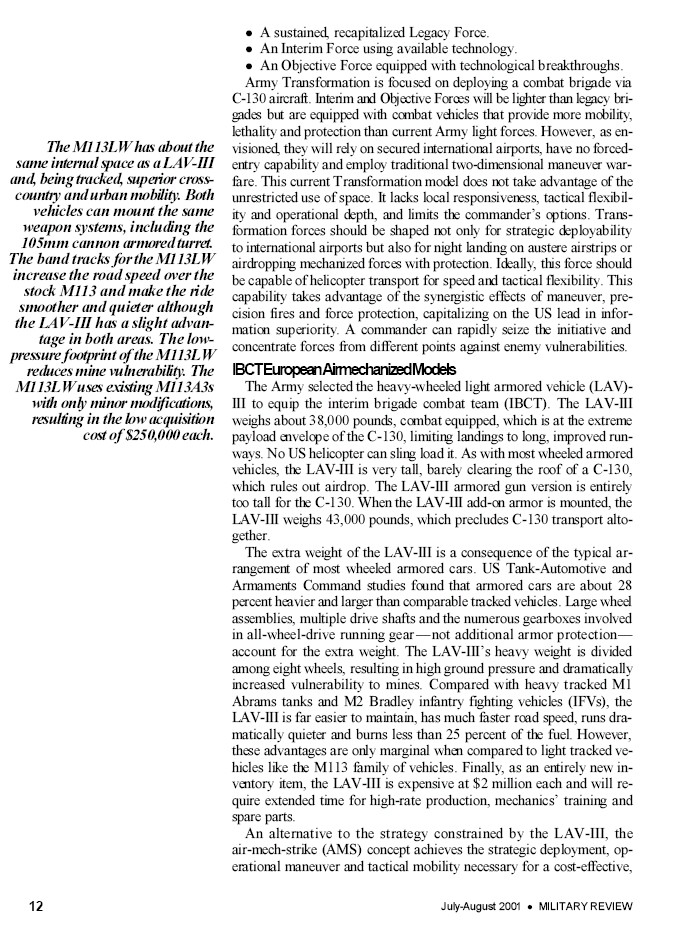









Carlton Meyer, Editor G2mil.com online military magazine
GPADS-Personnel: return of the Assault Glider!
Michael L. Sparks
RAND report "Analysis of Air-Based Mechanization and Vertical Envelopment Concept Technologies":
"We note that the air-mechanized (air-mech) battle force design and employment concept used in this study represented the work of the AAN study project in the FY96-98 timeframe and has no relationship to the current 'Air-Mech' concepts proposed by BG (ret.) David Grange and others.* The 'battle force' was a notional design construct used by AAN to analyze possible future organizational constructs without the constraints of current unit paradigms. The air-mech concept explored was the organic capability, within a battle force, to air maneuver both troops and medium-weight combat systems at both tactical and operational depths. TRADOC's Army Transformation Study, Wargaming, and Analysis effort has replaced the idea of organic operational airlift of systems with a more general-purpose capability for external lift assets (Army and/or joint) to enable operational maneuver by Objective Force units."
*David Grange et al., Air-Mech-Strike: 3-Dimensional Phalanx; Full-Spectrum Maneuver Warfare to Dominate the 21st Century, Paducah, KY: Turner Publications, August 2000.
Why are the RAND authors distancing themselves from General Grange and ours' AMS concept????
Vintage Maneuver Air Support: putting the "Strike" into Air-Mech-Strike:
2nd Edition Air-Mech-Strike: Asymmetric Maneuver Warfare for the 21st Century

Available since June 2002!
AMS-SG: U.S. Army BG David Grange (R), BG Huba Wass de Czege (R), LTC Richard Liebert, LTC Lester Grau (R), LTC Larry Altersitz, MAJ Charles Jarnot, MAJ Allen Huber, CPT John Wilson II, former marine CPT Carlton Meyer, LT Michael Sparks, SGT John Richards, Emery Nelson, Jacob Kipp, Carol Murphy

USAF Major Mike McKinney and Mike Ryan, August 2002
Army War College Transformation Report Praises Air-Mech-Strike and Breaking the Phalanx
It Maneuvers a Battalion: "Delta" weapons companies with advanced M113 Gavins can give A, B, and C company riflemen armored mobility as needed...while keeping them focused on dismounted warfighting skills and able to fight mounted, too.
2008
 Air-Mech-Strike Study Group Confronts U.S. Army on Past, Current and Future Force Structure & Operations!
Air-Mech-Strike Study Group Confronts U.S. Army on Past, Current and Future Force Structure & Operations!
http://usacac.leavenworth.army.mil/CAC/milreview/English/MarApr08/indexengmarapr08.asp
http://usacac.leavenworth.army.mil/CAC/milreview/English/MarApr08/BookReviewsMarApr08.pdf



Plain Text
Mounted Vertical Maneuver Today; When We Need It: Use Existing U.S. Army M113 Gavin Light Tanks
Mike Sparks, Air-Mech-Strike Study Group
In reading BG (Retired) Robin P. Swan and LTC (Retired) Scott R. McMichael's pro article, "Mounted Vertical Maneuver: A Giant Leap Forward in Maneuver and Sustainment,"¨ and LTC (Retired) John Gordon IV and COL (Retired) David E. Johnson's anti-article, "Air Mechanization: An Expensive and Fragile Concept"; (Military Review, January-February 2007), I found embedded factual errors that were either to justify new
Page 126 March-April 2008 Military Review
FCS vehicle/JHL aircraft purchases or [to show] that what we have or want is not good enough. BG Swann argued that we don't have any equipment to perform air-mech with and must buy new 27-ton FCS tracks and giant tilt-rotor JHL airlifters to obtain air-mech capabilities; he claims we don't have and never had. RAND's retired LTC David Johnson argued against this concept, saying all we have to perform air-mech with is road-restricted 20-ton Stryker trucks that are okay but somehow open-terrain; cross-country mobile, 27-ton FCS tracks that are too vulnerable; and the JHL, which is too easy to shoot-down while implying that air-mech has never worked in past combat operations.
The truth is we already have 15,000+ air-transportable, amphibious, closed-terrain, cross-country-mobile 11-ton M113 Gavin light tank/APCs that have been used for years in successful air-mech operations by several allied armies; including the U.S. Army.
We have 500+ C-130s, 180 C-17s, soon C-27J fixed-wing transports and 400 CH-47 Chinook helicopters to airdrop or airland Gavins; the former at higher speeds and altitudes to avoid enemy air defenses than any non-existent tilt-rotor. MVM air-mech combat operations have already been successful beginning with the German Me-323s airlanding SP assault guns into North Africa, British Hamilcars glider-landing Tetrarch and Locust light tanks on D-Day and the Rhine river crossing, Russian assault guns and BMDs airlanded into Czechoslavakia in 1968. In 1978 the Soviets did the first heliborne MVM, into East Africa, a feat they repeated [with fixed-wing aircraft] in Afghanistan later that year. The Israelis airlanded M113s at Entebbe, the Australians into East Timor in 1999, the British CH-47 air-meched Scimitar light tanks into the Balkans to avoid land mines and fly over the Sava river blocking our non-swimming medium-to-heavy vehicles. American Airborne units were the first to parachute drop M551 Sheridan light tanks into combat to link up with M113 Gavin APC task forces to collapse the PDF and prevent Noriega from escaping Panama in 1989. In 2001, M113 Gavins of General Meig's IRF-Medium were denied being flown into Camp Rhino in Afghanistan because it would make the Stryker truck purchases look unnecessary (they are). Resultantly, we didn't fan-out closed-terrain mobile forces to block Bin-laden's escape, and he remains free today. In 2003, the IRF-M was slowly C-17-airlanded into Northern Iraq when it should have parachute-inserted M113 Gavins immediately and fanned out to block Saddam/subordinates from escaping to Tikrit to start the rebellion against us.
Air-mech by high altitude delayed low opening (HALO) parachutes at 10,000 feet above enemy MANPADS solves shoot-down fears and was done in 1972 to resupply An Loc during the Vietnam warĄ another inconvenient fact not reported by either MVM author's group. The Russians jump with drogue chute deployed parachutes with delay devices to effect HALO capabilities; we could easily emulate by switching the new T-11 parachute from obsolete static-line and d-bag deployment means. Ram-air parachutes opening at high altitudes make M113 Gavin platform loads into de facto 25-mile stand-off gliders but with precision landing guidance. All we have to do is field the new parachutes and practice with them to get HALO/HAHO air-mech capabilities.
It's the quality of the vehicle's armor that counts not its parking weight; a 10-ton M113 Gavin hull of thick aluminum is far more protective than a road-bound Stryker truck with a thin steel box at twice the weight; this means superior armor layering can be added that coupled with v-hull shaping makes the Gavin not only more air-transportable for 3D maneuvers by C-130; it is superior in armor protection than a flat-bottom Bradley that is supersized carrying a turret armoring dead air. 27-ton FCS has turret inefficiency and cannot fly by C-130s nor drive through closed, vegetated terrain and cannot swim like Gavins can to strike at where enemies hide. High technology Gavins with land-mine resistant armoring, band-tracks, hybrid-electric drive are stealthy for 60-mph speeds. M113 Gavins can be reduced in size to roll-on/off from inside Army operated CH-47s and C-27Js to air-mech now by either airdrop or airland and should be supplied to every airborne, air assault, or LBCT infantry battalion; Delta Weapons Company; and/or HHC anti-tank and mortar sub-units to replace vulnerable Humvee trucks. The M113 was originally designed for light units by General Gavin for as-needed all-terrain, amphibious armored transport, and with TOW ATGMs can act as light tanks blasting enemy vehicles and strongpoints for the dismounting infantry. A sapper squad makes them Engineer Cavalry Troops able to breach mines with probing and towed-rocket line charges. Modularity LBCTs don't need or get 27-ton FCS or 20-ton Stryker trucks; they air-maneuver into closed terrains; it's high time they be equipped with M113 Gavin light tracks needed to fight better than M16 versus AK47 and RPG at a foot-slog.
AFPAK: Solution: Sensor-Security Fence Backed by M113 Gavin Quick Reaction Forces (QRFs)
Defense Review magazine
Mike Sparks, Air-Mech-Strike Study Group
Rhodesian Light Infantry FireForces: What We Should Already Be Doing in Afghanistan

M113 Gavin Parachute Airdrop Manual
Corrupt entities within the Army bureaucracy don't want warfighters and parachute Riggers to know they can parachute airdrop M113 Gavin light tanks. We are not going to let them get away with this. The FULL FM 10-567 airdrop manual for Tracked Personnel-Cargo Carriers is offered as a pdf file on the link above--as well as photo captures of the Gavin rigging steps and videos.
Air-Mech-Strike From the Sea: Save the USS Enterprise!
Budgetary pressures has forced DoD to realize we can no longer afford the bloated USN/Mc Expeditionary Fighting Vehicle (EFV) water-skiing through sea mines from over-the-horizon (OTH). The answer has and always will be to air-mech light tanks to shore in tactically sound, compact M113 AmphiGavins.
Mike Sparks, Air-Mech-Strike Study Group


DEFENSE NEWS, March 12 Upgrade M113sU.S. Army ARMOR, July-August 2012The up-engined tracked M113A3 Gavin beat the wheeled Stryker in congressionally mandated evaluation tests and outpaced the Bradley in the manufacturer's own mobility tests; the Army's spokesman for the AMPV is making false statements in public ["At AUSA: U.S. Army Moves Ahead With M113 Replacement," defensenews.com, Feb. 231.
The A3 Gavin, by being light (under 20 tons) and tracked (28 percent more space-weight efficient than wheeled trucks), has more uparmoring potential than either the 20-ton Stryker (made of thin steel) and the Bradley (made of thinner aluminum alloy than the M113), since it's not a bloated box with dead space for either a turret and a dangerous internal fuel tank or high on top of a wheeled suspension
Clearly, trying to con the American public to buy Strykers - which have failed in Iraq and Afghanistan and had to be removed from dangerous roles because they are road-bound wherever larger enemy land mines await - is unaffordable and dangerous. America's Army needs to be cross-country mobile to avoid land mines and defeat the enemy from unpredictable maneuver directions; the 33-ton Bradley is too heavy to traverse soft or rocky closed terrains and cannot be flown over by plentiful C-130 transport planes; a road-bound wheeled or too-heavy tracked Army will be again the cavalryless herd that gets ambushed or slams into the enemy blindly that Lt. Gen James Gavin warned about in the aftermath of the Korean War. The proper response then and today is to use light tanks in a cavalry more mobile than the main body, and have the maneuver assistance helpers (engineers, medics, light infantry, paratroopers, etc.) in upgraded M113A4 Gavins.
Congress should mandate that upgraded M113A4 Gavin variants (V-hull, RPG/ATGM-resistant armor, band tracks, remote weapon station 30mm autocannon) be tested against Stryker-Bradley AMPV prototypes by an honest outside evaluation agency to ensure true data is obtained, so our Heavy Brigade Combat Teams do not get ruined by less mobility/protection/ firepower. Honest data will show the most cost-effective and best AMPV is the Airborne Armored Multi-Purpose Vehicle Family: the program title of the M113. Moreover, Army Light Infantry Brigade Combat Teams need upgraded M113A4 Gavins available from modularity reorganization in their Delta Weapons companies to replace their fatally vulnerable Humvee trucks, and to provide battalion-level maneuver capabilities in the face of enemy fires. Details:
combatreform.org/itmaneuversabattalion.htm
MIKE SPARKS, Director, 1st Tactical Studies (Airborne)
THE VIDEO:
 http://youtu.be/xT0OemrI9Cw
http://youtu.be/xT0OemrI9Cw
THE ARTICLE (PLAIN TEXT)
Patton Was Not a Tankerby Mike Sparks
(Editor's Note: GEN George S. Patton's leadership is viewed here through the lens of a movie. While we recognise this is an unusual approach, it vividly points out Patton's enduring legacy. The movie this article is based on is Patton, a two-disc collector's edition DVD,
www.amazon.com/Patton-Two-Disc-Collectors-George-Scott/dp/B000EHSVS2/ref=pd_cp_d_O
The DVD includes an introduction by screenwriter Francis Ford Coppola; commentary by Coppola; "History through the Lens: Patton-a Rebel Revisited" documentary, "Patton's Ghost Corps", documentary; "The Making of Patton" documentary; production-still gallery accompanied by Jerry Goldsmith's complete musical score; and behind-the-scenes still gallery accompanied by audio essay on the historical Patton trailer.)
In 1970, my World War II combat-veteran father took me to see Patton starring George C. Scott. I know now from the two-disc collector's edition DVD release that Robert Patton, GEN George Patton's grandson--roughly my age--was also in a movie theater with his dad, Vietnam legend COL George S. Patton IV, having values passed down from father-to-son. In his case, grandfather-to-son-to-grandson.
I did not know what was happening then, all I wanted to see was battle "action" In fact, there is very little action in Patton. Patton is the most important American military movie to date and the most dangerous--if viewed wrong. When it premiered, Americans demoralized by failure in closed-terrain Vietnam wanted to latch onto an authority figure-a hero. They wanted someone to show them the way to victory. Patton is a reminder of "what right looks like" so we embraced it all --his vanity and outward appearances --without realizing the actual ulterior motivations.
Not long after, we ditched our blood-earned experiences in Vietnam in favor of reliving World War II at the Fulda Gap by building our own [heavy] supertanks to duel the Soviets in Europe's open terrain - Patton: the Cold War Sequel: coming soon to World War III in the European country nearest you.
Yet the actual way to victory was sitting in the theater watching his father win World War II. COL Patton's armored cavalry regiment had found a formula to win even in the closed terrain of Vietnam; but it involved using lighter tanks to maneuver--not duel--other tanks. Instead, a generation of Army leaders chose to recreate the Army depicted in the El Guettar battle scene- and not the actual content of the film, which shows how Patton used maneuver, not tank duels, to defeat the Germans.
Win wars, don't fight for the sake of ego. The damnest thing is that Scott, who is playing Patton, looks straight into the camera and tells the audience - like it was an assembled group of Soldiers - in the first lines of the movie: "The object in war is to make the other poor dumb bastard die for his country." Patton is telling us right then and there to stop with the narcissism of our own deaths and casualties as badges of honor - what matters in war is victory, and being alive to enjoy it, so let's get on with it. Do not be impressed or rely on battle to self- and peer-validate; be objective and professional, and get the results. War is not a duel. Patton is telling us right there to not obsess with tank dueling. Win battles. He then tells us how to do it--with maneuver.
"We are going to hold them by the nose, then kick them in the pants." Patton is saying that one maneuver axis will hold tile enemy's attention so another -a cavalry that is more mobile than the main body - will go around and defeat the enemy by Maneuver-Terrain-Leverage (MTL); not slamming into the enemy and dueling him. This is the whole thrust (pardon-the-pun) of the movie.
There is not much battle action in Patton because Patton is winning by maneuver.
This is the secret of his confidence and tile true meaning of the movie. Gain the MTL and the enemy will be defeated because he is off-balance and in a no-win situation--exactly what we refused to do in Vietnam by not stopping the closed-terrain infiltration and holding-them-by-the-nose. Instead, we went all over Vietnam (and later Cambodia) trying to kick the enemy-in-the-pants--without first holding him in place. In this special-edition DVD, 25th Infantry Division combat veteran and director Oliver Stone said the movie Patton convinced President Richard Nixon to invade Cambodia and then leave -resulting in the destabilization of that country into communist genocide. The real GEN Patton said always get a winning CONcept Of OPerationS (CONOPS).
Throughout the movie, once you decipher that "it is the maneuver, stupid"--not battle - you will see Patton surrounded by others who simply do not get it. They see the only ways to will are by slamming into the enemy and suffering casualties by combat. They are the GEN Bernard Montgomerys of the British army who want to build up supplies and slam into the enemy as the only way forward.
When planning to seize the island of Sicily at the southern end of Italy, Montgomery wanted to land in tile south and drive north with Patton on his left - "two big blue arrows" massed in one direction - but the enemy clearly saw and reacted against this. Patton wanted to land elsewhere and surprise the enemy at Palermo, at the island's north, and head east to cut off the German retreat as Monty pushed up.
The cautious and tactically naive Eisenhower - even though he had just seen the Kasserine Pass consequences (dead Americans in the desert after Rommel attacked them in the movie's second scene) when Operation TORCH landings missed taking Tunisia - opted for the conservative approach and ordered Patton to land to Monty's left. Had Patton landed where he wanted, the Germans would have been trapped on Sicily and not lived to hold us off for two more bloody years in the mountains on Italy's boot.
Patton made do.
He detached a part of his force and drove north to Palermo, where he wanted to start from in the beginning, then headed cast by a series of small amphibious landings to unhinge the Germans tactically. MG Lucian King Truscott of 3rd Infantry Division stormed into Patton's headquarters and demanded a 24-hour delay so his men could rest before the amphibious landings. Patton refused and explained that the key was to be audacious and exploit the enemy's unpreparedness.
Patton said that in the long run it would save lives, but this fell on deaf ears because it was misinterpreted as excuses so he could gain personal-ego benefit over rival Montgomery by reaching Messina first. Coppola smeared Patton's sound military ail by citing his vanity and narcissism. The DVD special-edition documentary reveals that Patton's overbearing behavior - "a gentleman must be able to curse non-stop for three minutes without repeating himself" - was a deliberate showmanship tactic of visible personality to buck up citizen-Soldiers with little military drive.
Karl Malden's GEN Omar Bradley did an eloquent job of explaining how the Soldier had no dreams of military glory and just wanted to survive. However, in the anti-war vein in which the movie is written, Scott's Patton's true argument that "bold maneuvers will save lives and shorten the war" is lost. One walks away thinking that being the nice-guy Bradley and just slugging it out- as told by the bureaucracy - is somehow best serving the Soldier when really it is not.
However, there was some very interesting character development in Bradley later in the film. After D-Day the Allies were stuck in the hedgerow country of France. Monty couldn't take the city of Caen, which was defended by the weight of German panzers. After
July-August 2012 ARMOR
realizing Patton was right all along, Bradley finally offered Operation COBRA, where Monty held the Germans' attention and out came Patton's Third Army in behind them. Hold-them-by-the-nose, then kick-them-in-the-pants.
Bradley had changed. He represented the change the audience was supposed to realize, but more often than not, unsophisticated Americans only see the outward mannerisms of Patton and assume it means that the formula for success is being an overbearing donkey and slamming into the enemy. They fail to decode the real message of the movie-and Patton's life--which is maneuver.
Patton defends against the Afrika Corps.
The opening-scene speech also has Patton saying that we are not going to defend anything, but keep on moving until we get to Berlin and collapse the Nazi government and end the war. Note this is a fragment from a speech to troops in France on the same land mass as Germany--not North Africa. Many use this speech to protest developing any kind of defensive excellence in America's army; it also contradicts Patton's words that we need to hold-the-enemy. In fact, the very first battle scene has Patton in defense at El Guettar. Oops.
It's clearly a flaw in the film that screenwriter Francis Ford Coppola-who has no military background-unintentionally created by assembling a montage of Patton speech quotes from different times and places to be a representative example. This has made the false impression that Patton was against ever being in defense that has had severe and fatal repercussions in U.S. military practice and thought.
Americans - impatient and lazy by nature - want a quick victory by an offensive drive on a Berlin or a Baghdad to collapse a nation-state war foe. Afterwards, however, we have to hold what we have for it to be of any value, be it a Germany, an Iraq or an Afghanistan. If we are not willing to hold-the-enemy--regardless if he is outside or inside - by fortified lines, walls or security fences at the border, we will end up chasing the devil all over the bush trying to kick-him-in-the-pants.
The Mannerheim line saved Finland from the Soviet army; the Morice line gave the French a chance for victory in Algeria and keeps Israel safe today. A sensor-security line-backed by quick-reaction forces and composed of Patton's son's Armored Cavalry Regiment-like light armor --is what we need to secure Vietnams by holding-the-enemy-by-the-nose and kicking-him-in-the-pants.
Coppola is fired - then wins an Academy Award.
Another interesting feature of the Patton special-edition DVD is Coppola tells us in an interview that he was fired from the film and was about to be fired from The Godfather when the film based on his script won several academy awards for best picture, best actor and--you guessed it--best screen play. He received vindication!
Coppola kindly tells young people not to take to heart rejection by a bureaucracy for what you know is right. Stick-to-your-guns. Stick to what you know is true. He wanted to show all the sides he could of Patton - and he did a brilliant job since its layers are thick and we are still decoding it today. It's not his fault we fail to properly decode the film.
Coppola says he wanted to show Patton as a military rebel to appeal to the "doves" at the time. Just what is he rebelling against? Bureaucracies - not just military ones - want to homogenize everyone to conform and be like everyone else. Yet this only creates a main body; a herd that can only do so much, since it otters no other direction.
Patton in his writings warned constantly against being a "yes-man" in military bureaucracies, yet his admonitions were ignored. Nobody wants to die, and when confronted with death daily in war, the natural tendency is to bunch up, herd together and try to force the issue with numbers alone. Quantity, not quality. Stick-the-nose-to-the-grindstone. Yet, with precision-guided munitions increasingly dominating land warfare, there is no safely in large numbers. Each target presents risks for destruction, for real, just as the first battle in Patton --except every tank is destroyed unless protected by a smokescreen and/or countermeasures.
We are not helping the Soldier by sending him to his death if he is going in a predictable direction in increasingly wheeled trucks that are stuck to roads/trails where the enemy awaits with ever-bigger land mines and missiles. We must be able to "do a Patton" and land by sea or air at an unexpected place and time, and drive cross-country into the enemy with a cavalry in lighter tanks --like the variants of the M113 Gavin that COL, Patton's ACR used in Vietnam.
Cavalry must think dozens of miles ahead - not just the grid square or two in front of a walking infantryman. The infantry or "dragoons" we need must ride swiftly, stealthily and with armor protection in their own light tanks--not be walking bunched up by their tanks--or they will destroyed as "a waste of fine infantry," as Scott's Patton laments in the film.
Fast-forward to Lebanon in 2006 and see "fine Israeli Defense Force infantry" chopped up following tanks on foot straight into the dug-in enemy. Hezbollah read the IDF's "playbook" and was ready and waiting. The "Ghost Corps" documentary on the DVD set illustrates what happens when infantry lacks tanks. It further demands that our current tank-less light-infantry brigade combat teams have their own high-technology M113 Gavins to ensure they always have their own tank fire support and armored transport.
If we want to win wars - and not suffer stalemates in places like Caen, Beirut, Mogadishu, Iraq and Afghanistan - we must not duel our enemies, be they in other tanks or on foot. The object in war is to make the other guy die; if he resists you, outmaneuver him by using the terrain and situation against him so his goals are defeated. That is the message of Patton.
Patton was not a tanker; he was a maneuverist.
***************************************************************************
Mike Sparks is a former U.S. marine corps and Army infantry non-commissioned officer and officer. He currently directs the non-profit 1st Tactical Studies Group (Airborne). He edits the electronic publication, Air-Mech-Strike: Asymmetric Maneuver Warfare for the 21st Century: combatreform.org/AIR MECH STRIKE
Mr. Sparks' previous assignments include special project officer for Air-Mech-Strike Study Group, which restored the last surviving YCH-47A Chinook helicopter; platoon leader for an U.S. Army Reserve unit mobilized for Operation ENDURING FREEDOM-IRAQI FREEDOM; and operations officer for airborne headquarters and training units. His military education includes Infantry Officer Advanced Course Phase l, U.S. Army and Israeli airborne schools, Combat LifeSaver Course, Retention NCO/ Career Counselor Course, USMC Officer Basic Course, Infantry Officer course, Platoon Leader Course Junior and Senior (Officer Candidate School), Enlisted Reserve Communications, Fleet Security Force Cadre Weapons Instructor Course and Infantryman 0311 military occupation specialty school. He holds a bachelor's of science degree in history from Liberty University. He is the author of James Bond is Real: the Untold Story of the Political-Military Threats Ian Fleming Warned Us About (jamesbondisforreal.com).
ACRONYM QUICK-SCAN
ACR - Armored Cavalry Regiment
DVD - Digital Versatile Disc
IDF - Israeli Defense Force
MTL - Maneuver-Terrain-Leverage
NCO - Non-Commissioned Officer
USMC - U.S. marine corps



